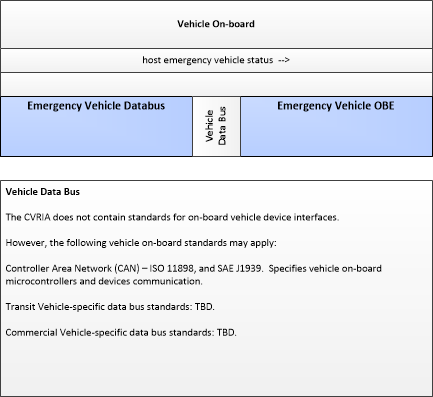Link Type: Vehicle On-Board
Emergency Vehicle Databus --> Emergency Vehicle OBE:
host emergency vehicle status
Definitions
host emergency vehicle status (Information Flow): Information provided to the Connected Vehicle on-board equipment from other systems on the Emergency Vehicle Platform.
Emergency Vehicle Databus (Source Physical Object): The 'Emergency Vehicle Databus' represents the vehicle databus that interfaces with on-board equipment on a public safety vehicle. It is a specialized and extended form of the Vehicle Databus that may be subject to different vehicle databus standards and hosts a broad range of components that are specific to emergency vehicles including the lightbar/siren and on-board apparatus that supports law enforcement, firefighting, and emergency medical services. As a specialized form of the Vehicle Databus, it also provides access to the general-purpose sensors (e.g., radars, cameras), GPS, drive train monitoring and control systems, and vehicle safety features that support connected vehicle applications. In CVRIA, the 'Emergency Vehicle Databus' is used to represent the onboard interactions between the Emergency Vehicle OBE and the other systems included in a host emergency vehicle.
Emergency Vehicle OBE (Destination Physical Object): The Emergency Vehicle On-Board Equipment (OBE) resides in an emergency vehicle and provides the processing, storage, and communications functions that support public safety-related connected vehicle applications. It represents a range of vehicles including those operated by police, fire, and emergency medical services. In addition, it represents other incident response vehicles including towing and recovery vehicles and freeway service patrols. It includes two-way communications to support coordinated response to emergencies. In CVRIA, a separate 'Vehicle OBE' physical object supports the general V2V and V2I safety applications and other applications that apply to all vehicles, including emergency vehicles. The Emergency Vehicle OBE supplements these general capabilities with capabilities that are specific to emergency vehicles.
Included In
This Information Flow is in the following Applications:
- Emergency Vehicle Alert
- Emergency Vehicle Preemption
- Incident Scene Pre-Arrival Staging Guidance for Emergency Responders
- Incident Scene Work Zone Alerts for Drivers and Workers
- Road Weather Information and Routing Support for Emergency Responders
- Vehicle Emergency Response
This Information Flow is in the following Application Objects:
Communication Diagrams
The communication diagram(s) can be viewed in SVG or PNG format and the current format is SVG. Switch to PNG format.
Characteristics
Architectural:
| None defined |
Security
This information flow triple is in the following applications with the following security levels.
| Information Flow Security | |||||
|---|---|---|---|---|---|
| Application | Confidentiality | Integrity | Availability | ||
| Basis | Basis | Basis | |||
| Emergency Vehicle Preemption | Moderate | Moderate | Moderate | ||
| This could contain sensitive or proprietary information. | This is where the Emergency Vehicle OBE acquires GPS information, etc. This information is used elsewhere, leading to this rating. | This information needs to be mostly available to the system for this application to work. | |||
| Incident Scene Work Zone Alerts for Drivers and Workers | Moderate | Moderate | Moderate | ||
| This could contain sensitive or proprietary information. | This is where the Emergency Vehicle OBE acquires GPS information, etc. This information is used elsewhere, leading to this rating. | This information needs to be mostly available to the system for this application to work. | |||
